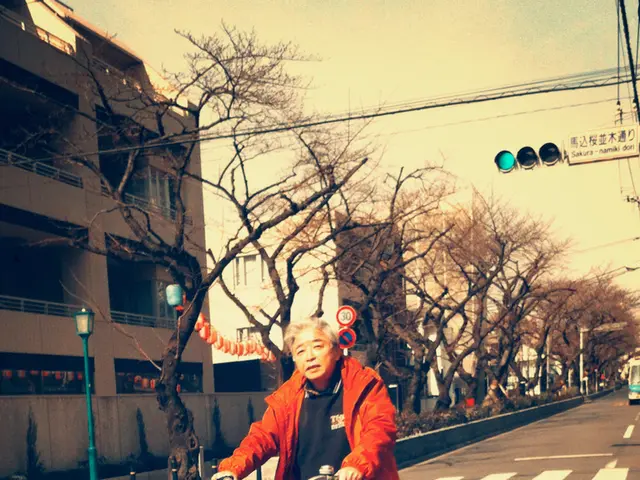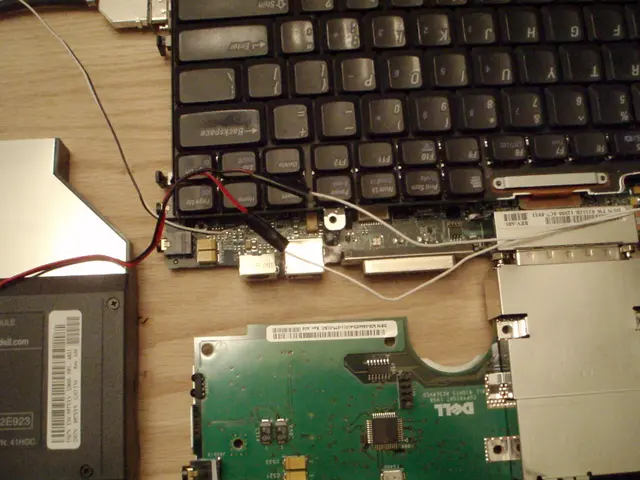Asset monitoring: What does it entail? The significance and methods of keeping tabs on your assets explained.
Unraveling the Mystery of Asset Tracking: Boost Your Business Efficiency
Struggling to keep track of high-value assets such as machinery or critical equipment can be a frustrating challenge for many businesses, especially in sectors like healthcare, construction, and warehousing. But help is on the horizon. In this blog, we delve into the world of asset tracking, exploring its significance, benefits, and practical strategies for implementation.
The need for efficient asset management is clear: inadequate oversight of valuable assets can lead to operational disruptions, increased costs, and reduced asset lifespans. Asset management is no longer an option but a necessity that can help streamline operations and boost overall company efficiency.
In this enlightening post, we will:
- Unravel the essence of asset tracking: address common misconceptions and highlight its importance in today's business landscape
- Elucidate the advantages of effective asset tracking: from reducing loss and theft to optimizing resource utilization
- Offer clear-cut steps for enhancing inventory tracking and cutting back on asset loss
- Share practical strategies for managing assets smoothly and efficiently
By the conclusion of this engaging read, business owners will be better prepared to safeguard investments, streamline operations, and enhance overall efficiency in their companies.
...
As we grow increasingly data-driven and tech-reliant, the benefits of asset tracking become more obvious. IoT in logistics, for instance, empowers businesses to make informed decisions and optimize their supply chains. To delve deeper into the benefits of smart logistics, visit our article entitled "What Are The Benefits Of Smart Logistics?"
In a nutshell, asset tracking is akin to providing GPS functionality for your valuable possessions. By employing asset tracking technology, businesses can stay abreast of their assets' location and performance, ensuring operations are uninterrupted and any misplaced items can quickly be accounted for.
Explore the various asset tracking technologies available and find the ideal fit for your business in the article "6 Types Of Asset Tracking Technologies And Which One Is The Best For Your Business".
Tracking Your Assets: 7 Common Methods
Global Positioning System (GPS)
GPS technology functions as a satellite-based navigation system that provides location and time information in any weather conditions, anywhere on Earth with an unobstructed line of sight to several GPS satellites. Organizations can attach GPS devices to valuable assets such as vehicles, machinery, or equipment to have real-time visibility and control over their assets' whereabouts. GPS is particularly valuable for monitoring assets that are mobile or located over extensive distances due to its wide coverage and ability to ensure asset security.
Consider our comprehensive guide "15 Best GPS Tracking Devices For Your Equipment [2025]" for top-performing GPS tracking options suitable for various industries.
Pros:
- Real-time location data
- Wide coverage
- Enhanced security
- Improved efficiency
- Useful data on asset usage and movement patterns
- Automated alerts offering swift response to unapproved activities or deviations from planned routes
Cons:
- Signal dependency, which may hinder performance in urban areas, forests, or buildings with signal obstructions
Some of the leading GPS asset tracking providers include:
- our website: renowned for IoT-enabled GPS tracking solutions offering real-time, reliable, and accurate location data
- Fleet Complete: provides GPS solutions for monitoring a wide array of assets, from heavy-duty equipment to smaller tools
- Verizon Connect: offers GPS software and hardware solutions designed for real-time tracking and visibility of assets
Bluetooth Low Energy (BLE)
BLE is a wireless personal area network technology that prioritizes low power consumption while maintaining similar communication range to conventional Bluetooth technology. BLE beacons are tiny battery-powered devices that transmit unique identifiers, making asset tracking possible in indoor environments where GPS may not work efficiently.
Access more insights about our company's innovative PELICAN and PELICAN Ex devices, both employing BLE technology for efficient asset monitoring, by visiting our website.
Pros:
- Low power consumption
- Cost-effectiveness
- Ideal for indoor tracking
- Scalability, making it possible to expand by adding additional beacons and devices when needed
Cons:
- Limited range, typically 100 meters
Key BLE asset tracking providers include:
- our website: offers innovative IoT-enabled BLE tracking solutions for accurate asset surveillance, user-friendly asset management software, and reliable hardware
- Zebra Technologies
- Estimote
Searching the Convergence of Innovation and Efficiency: Asset Tracking with Near Field Communication (NFC)
Near Field Communication (NFC) is a short-range wireless technology allowing data exchange between devices within approximately 4 centimeters. In its applications for physical asset tracking, NFC utilizes small, battery-free tags printed with unique identifiers that can be scanned by smartphones or dedicated scanners.
Pros:
- Low cost
- Easy to implement and use
- Quick data transfer
Cons:
- Limited range
- Manual scanning, which can be time-consuming for large numbers of assets
- Limited data storage capacity
- Interference potential from metal or electronic devices
Key NFC asset tracking providers include:
- Smartrac
- Identiv
- Avery Dennison
Beyond the Horizon: Radio Frequency Identification (RFID)
RFID employs electromagnetic fields to identify and track assets automatically, even without direct line-of-sight. The technology offers real-time asset visibility through utilizing RFID tags and readers.
Pros:
- Range: Active RFID tags can be read from several meters away
- Automated asset tracking
- Large data storage capacity
- Suitability for large-scale asset tracking across varied industries
Cons:
- Higher initial setup costs for tags and readers
- Interference from metal and liquids
- Privacy concerns
- Complexity required for implementation and maintenance
Key RFID asset tracking providers include:
- Alien Technology
- Impinj
- Honeywell
Barcode (QR Code) Tracking: Simplicity Meets Efficiency
Barcodes and QR codes are machine-readable labels containing information about attached assets. They are compatible with a wide array of scanners and devices, allowing for quick access to asset data.
Pros:
- Low cost
- Ease of use
- Wide adoption
- Instant access to asset data with quick scans
- Versatile applications across multiple industries
Cons:
- Manual scanning required, which can be time-consuming for large numbers of assets
- Limited data storage capacity
- Physical wear and tear, leading to device unreadability
- Requires direct line-of-sight for scanning
Key QR code asset tracking providers include:
- Zebra Technologies
- Datalogic
- Socket Mobile
Success Stories: Asset Tracking in Practice
SPARROW Sensor: Transforming Efficiency in a Mauritius Hospital
The SPARROW sensor, one of our website's offerings, recently revolutionized the management of valuable medical devices at a hospital in Mauritius – enhancing nurse efficiency and Asset Life Cycle Management.
Key improvements reported include:
- Real-time asset visibility
- Streamlined use of equipment
- Lower costs due to reduced equipment loss
The Locus platform from our website further facilitated smooth deployment, offering real-time alerts, geofencing features, and seamless integration with the hospital's existing software.
By implementing the SPARROW sensor, the hospital in Mauritius has seen marked improvements in efficiency, resource allocation, and cost management.
ORCA Trackers: Securing the Adriatic Sea's Navigation
The deployment of our website's ORCA Asset Trackers proves fruitful for the safe navigation of sea buoys in the Adriatic Sea. This technology elevates maritime safety while optimizing navigation efficiency.
Key benefits witnessed:
- Real-time monitoring of sea buoys
- Enhanced maritime safety due to optimized navigation routes and reduced response times
- Streamlined operations with safe navigation paths
Highlights of the ORCA Tracking System:
- Continuous tracking offering real-time data
- Rapid response during emergencies
- Risk minimization for both marine life and valuable maritime assets
- User-friendly web application offering clarity and accessibility
By utilizing the ORCA tracking system, the Adriatic Sea's maritime operations have seen considerable improvements in safety, efficiency, and environmental protection. This success story underscores the powerful impact of advanced asset tracking technologies on maritime safety and operational excellence.
The Unveiled Advantages of Asset Tracking
Asset tracking offers businesses the following key benefits:
- Real-time visibility
- Cost savings
- Improved efficiency
- Better maintenance
- Enhanced security
- Data-driven decisions
- Compliance and reporting
- Increased customer satisfaction
Asset Tracking Guidelines for Peak Performance
By adhering to the following guidelines, asset management becomes smoother, allowing for the streamlined operation of your business:
- Set clear objectives for asset tracking
- Utilize robust tracking devices tailored to your needs
- Select reliable asset tracking software
- Embrace real-time tracking for data-driven decision-making
- Activate automated alerts for critical events
- Analyze data for operational optimization
- Ensure compliance and security
- Plan for scalability
- Partner with a reliable and knowledgeable asset tracking provider
By following these guidelines, your asset tracking efforts will be more effective, enabling you to protect investments, streamline resource allocation, and boost overall efficiency in your organization. If you have further queries or need guidance in implementing an asset tracking solution tailored to your unique business needs, our website's experts are more than happy to help.
It's crucial to choose the right asset tracking solution for your businesses' unique requirements. Whether you require robust, real-time tracking for high-value assets in large environments or centimeter-level accuracy for subtler monitoring, the variety of asset tracking technologies available ensures precision and adaptability.
Our website's solutions, renowned for their innovative IoT-enabled tracking devices, durability, and long-lasting performance, offer versatility to suit various industries' needs. For organizations dealing with challenges such as large sites, theft prevention, or mobile assets, the integration of GPS, cellular IoT, RFID, or satellite trackers can make a significant difference in operational efficiency.
By staying apprised of emerging trends such as AI and IoT integration, digital twins, and cloud-based asset management, businesses can further elevate their asset tracking systems, unlocking new avenues for efficiency and growth.
You know? The benefits of IoT in logistics are extensive, helping businesses make informed decisions and optimize their supply chains. To learn more about how TECTELIC's solutions can enhance your smart logistics operations, read the article "What Are The Benefits Of Smart Logistics?"
In the quest for optimal asset management, businesses can capitalize on the following domains:
- Fashion-and-beauty: Simplify inventory tracking and reduce pilferage through the use of QR code or RFID tags on merchandise
- Lifestyle: Monitor elderly or vulnerable individuals with specialized GPS devices, ensuring their safety and well-being
- Food-and-drink: Boost traceability of perishable goods through RFID tracking, preserving freshness and quality while reducing waste
- Home-and-garden: Locate gardening equipment through BLE beacon technology, streamlining maintenance tasks
- Gadgets: Protect valuable electronics from theft using GPS tracking devices, providing peace of mind for owners
- Data-and-cloud-computing: Track critical hardware components through RFID or GPS, aiding in data center asset management
- Technology: Monitor the location and status of prototype or development equipment using BLE or RFID tracking, enabling real-time progress updates
- Artificial-Intelligence: Secure AI infrastructure through cutting-edge cybersecurity measures and tracking solutions to monitor asset vulnerabilities and secure data
- Books: Implement RFID to manage book inventories and enhance library loan tracking
- Shopping: Utilize smart shelves with built-in RFID or QR code scanners to automate inventory management in brick-and-mortar stores
- Social-media: Monitor social media assets through analytics tools, assessing brand performance and trends
- Movies-and-tv: Track filming equipment and props using GPS or RFID, ensuring precise accounting and security
- Casino-and-gambling: Use RFID for gaming chips or tokens to optimize operations and detect any illicit activities
- Entertainment: Monitor event equipment for arts and cultural venues via GPS or RFID tracking, preventing loss and theft
- Sports: Track soccer, baseball, hockey, golf, basketball, and other sports equipment through GPS, enhancing inventory management and reducing loss
- Sports-betting: Secure digital sportsbooks through cybersecurity solutions and asset tracking to safeguard sensitive user data and betting information
- Racing: Keep track of racing cars, horses, and jockey gear through GPS or RFID technology, improving performance and accountability
- American-football: Utilize RFID for tracking player helmets and uniforms, managing inventory and increasing team efficiency
- Weather: Raycaster weather forecasting system uses satellite data to track weather patterns and offer real-time updates, aiding in agriculture, aviation, and outdoor event planning
- Tennis: Monitor tennis court conditions through IoT sensors, automating maintenance tasks and offering real-time court data for players
- Mixed-martial-arts: Track fighter equipment and training supplies through GPS or RFID, enhancing inventory management and reducing loss
- Sports-analysis: Using AI and machine learning to analyze sports data, improved asset tracking can offer insights for training, game strategy, and performance enhancement
- Weather-forecasting: IoT sensors placed throughout cities and rural areas can enhance weather data collation, offering more accurate and accountable forecasting
- MMA-training: Optimize MMA training effectiveness by monitoring trainee equipment and progress using GPS or RFID tracking and analysis software
- Public-safety: Smart city initiatives can leverage various tracking technologies to enhance public safety and emergency response capabilities
- Agriculture: Utilize IoT sensors on plants, soil, and farm equipment to optimize irrigation, fertilization, and equipment maintenance, improving crop yields and reducing waste
- Construction: Monitor heavy machinery, tools, and building materials through GPS or RFID tracking, ensuring efficient site management and preventing theft
- Mining: Enhance mining operations through RFID asset tracking, improving equipment productivity, safety, and worker efficiency on mining sites
- Legal: Tracking evidence and legal documents through RFID or QR code technology, ensuring accountability and chain of custody
- Automotive: Monitor automobiles and their parts through GPS or RFID tracking, enhancing supply chain management and inventory control
- Shipping: Utilize GPS tracking for cargo shipments, providing real-time updates and optimizing delivery routes
- Healthcare: Advanced asset tracking through RFID and IoT sensors can aid in facility management, medical device tracking, and inventory control, ensuring efficient operations and patient safety
- Military: Military equipment and personnel tracking through various technologies including GPS, RFID, and satellite tracking, improving situational awareness, and overall mission effectiveness
- Logistics: Leverage IoT and RFID technologies for real-time asset tracking across the logistics industry, streamlining operations and enhancing efficiency.
By embracing asset tracking innovations, businesses can boost their operations' efficiency, streamline resource allocation, and protect investments across diverse sectors.








